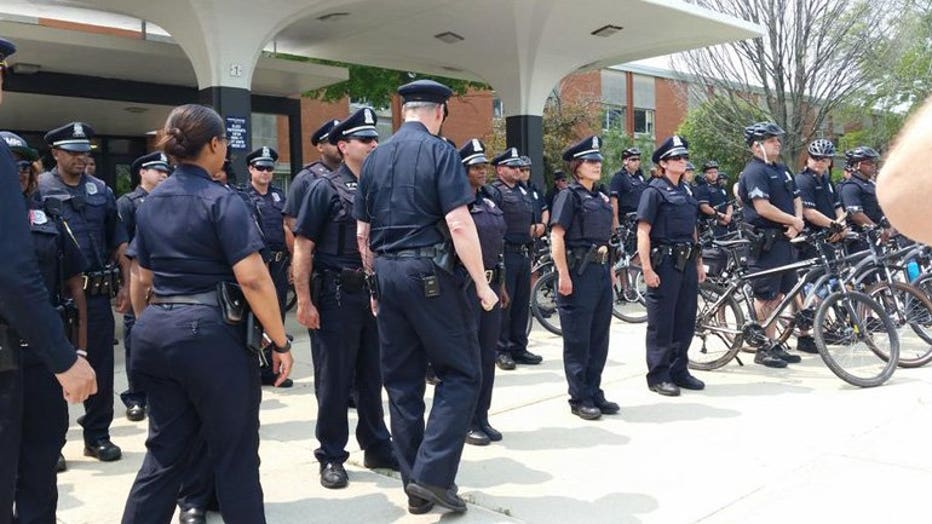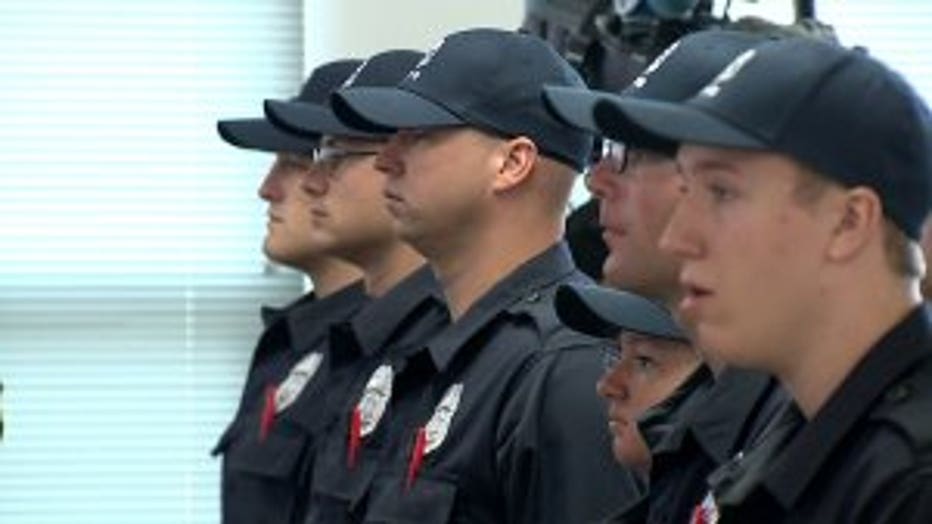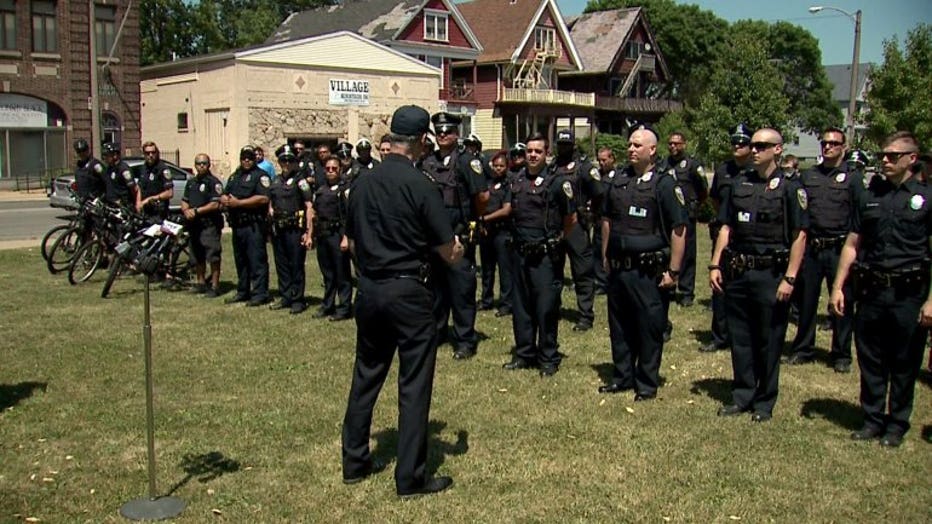Mayor Barrett's 2017 budget includes more money for MPD; but staffing levels will remain the same
MILWAUKEE -- Milwaukee Mayor Tom Barrett on Monday, September 26th presented his 2017 budget to the Milwaukee Common Council. Barrett said while his budget includes more money for the Milwaukee Police Department, staffing levels will remain the same.
Mayor Barrett said he must maintain the current staffing levels because of increasing pension costs, and because less money is coming from the state.
"The police department budget of $302 million is more than our entire property tax levy," Barrett said.

Milwaukee Police Chief Ed Flynn conducts roll call at James Madison Academic Campus
Mayor Barrett said people should be proud the city can maintain the police force.
"This year, not even for the next year's budget, this year alone we are putting $127 million more into the police department and its pension than we did in 2004," Barrett said.

Barrett said his budget proposal pays for 1,888 officers.
"More than 165 new police officers will be in our Police Academy in 2017. New officers will be on the job filling positions of officers we anticipate will retire," Barrett said.
Barrett also pointed out there is millions less in "shared revenue" from the state.
"$12 million less. That will tell you the challenges we face," Barrett said.

From public safety to public works, Barrett has pledged $11 million to combat lead issues -- both lead paint and lead pipes.
"We will use $5.2 million in 2016 and 2017 to remove lead lines in 385 licensed day care facilities," Barrett said.
On top of that, Barrett said he's setting aside money to replace approximately 300 residential lines when they fail.

"In 2018, what we want to do is, whenever there is a replacement on the public side, we want the private side to replaced at the same time," Barrett said.
Barrett asked members of Milwaukee's Common Council to support ordinances requiring mandatory lead service line replacement while he and others go after state and federal money to help residents pay for it.
Of course, this is Barrett's initial budget proposal.
Future budget hearings can always lead to the mayor tweaking his budget.
Mayor Barrett’s 2017 Executive Budget Address: September 26, 2016
As Prepared for Delivery
Good morning.
Thank you Mr. President, members of the Council, City Attorney Langley, Comptroller Matson, Treasurer Coggs, members of the cabinet and members of the public. It is a pleasure to be here this morning as I present my 2017 Executive Budget.
We all know, Milwaukee as a city, faces big challenges and at the same time, is asked to tackle these challenges with significant fiscal limitations.
We have neighborhoods where private sector development is booming. On the flip side, we have neighborhoods where violence is far too frequent, vacant homes are common, and jobs and hope are lacking. These disparities – and the frustration – are unacceptable.
My budget is designed to advance our work – to serve our residents in ways that are respectful and fair.
This budget moves us forward using approaches that are sound, programs that have demonstrated success, and new initiatives that address safety and success for everyone in Milwaukee.
The 2017 tax-levy budget totals $263 million. That’s an increase of $7 million over 2016. The proposed tax rate will increase seven cents. The average home will see an increase of $26.40.
The 2017 municipal service fees will increase by $10.86 for the typical homeowner.
The recent Public Policy Forum report made it clear: the State of Wisconsin is no longer the partner it once was. The State has decreased financial support for Milwaukee. It has restricted our financial options and paid less and less attention to our pressing needs.
We know the challenges that exist in this community. We have an obligation to provide essential City services. We have a big role to play in the health of our neighborhoods, and we must make important differences in the lives of every resident.
Let’s begin by looking back. As the Public Policy Forum reported in 2009, the City faced an unmanageable situation---daunting expenses, aging infrastructure and little hope for growth in revenue.
Now look what has changed seven years later. The Forum says our financial condition and outlook have improved significantly and that the improvements we have made are evidence of effective financial management.
It’s important to pay close attention to how we made these improvements and it is absolutely essential that we manage our long-term obligations. Chicago is in fiscal crisis because it has failed to do so.
To avoid similar problems in Milwaukee, we must work to keep current with our expenses and avoid passing costs on to future generations.
With your help, that’s exactly what we have done. In 2010, the City faced its first employer pension contribution in 15 years, a contribution of $47.9 million. And we knew this would grow. It would have been easy to kick the can down the road, and pretend the situation would resolve itself.
Instead, we worked collaboratively to develop responsible changes to the pension funding formula. We eliminated positions in the 2010 Budget. We reduced expenditures and implemented furlough days. And we included the entire contribution amount without resorting to pension obligation borrowing.
As we have faced big cuts in State aid, we have consistently met our obligations making the full contribution without pension borrowing and without passing obligations on to future taxpayers.
We were also faced with City health care expenditures rising 8% to 9% a year, putting us on a course that would have destabilized the City Budget.
We made changes. We switched from an insured plan to a self-funded plan saving $6 million a year. With the help of our employees, we modified premiums and other cost-sharing features, while maintaining very fair coverage and a broad provider network. Our wellness program is helping employees and generating cost reductions at a rate of $2 million a year.
It has paid off. Amazingly, we will be spending $25 million less on health care this year than we did in 2011.
As daunting as the triple whammy of increased pension obligations, rising health care costs and cuts in State Aid were, we never lost sight of the need to address the day-to-day concerns of our residents.
Over the last three years, we have increased funding for core infrastructure by nearly 85% addressing a backlog in street and sewer replacements.
We continue to make progress on our comprehensive library replacement plan. Two new neighborhood libraries have been constructed and a third has undergone substantial renovation. Two additional neighborhood library projects, Mill Road and Forest Home, are on their way.
We have faced unexpected demands, like the City Hall Foundation project, that have pushed our new debt authorizations to a level we cannot maintain.
Challenges remain and the two biggest fiscal challenges are City debt and pensions.
Long-term obligations must always have our attention. Remember, regardless of how low the interest rate is, we always have to pay back the principal. We, as a city, should aim for a levy-supported debt target of $75 million by 2021.
But here’s a big problem. Unless the State of Wisconsin increases its commitment to Shared Revenue, or provides local governments with more control over revenue options, we will be forced to make additional reductions to personnel and City services.
Take a look at the Police Department budget. In the last 12 years, I have increased the police department’s budget every year. This year alone, we will be spending $127 million more than we did in 2004 for the Police Department and its pension. In sharp contrast, the State has slashed state shared revenue and expenditure restraint funds by $12 million per year.
And, don’t forget ACT 176, the State’s gift to slumlords. That recent law cut fees for chronic building code violators by millions.
Think of the expectations of City government. We fight crime and put out fires. We rush to medical emergencies. We pave the streets and enforce safety requirements. We promote public health and we add to the quality of life for everyone. We are a partner in community development, in resolving the foreclosure crisis, in promoting business growth and in preparing our children for success. And, there are even more demands for public safety, for city services and for a growing population, now above 600,000 people.
The police department budget of $302 million is more than our entire property tax levy . And in fact, for several years, it has been more than we receive annually in shared revenue. Despite the fiscal challenge, we have maintained our commitment to a well-staffed police department.
More than 165 new police officers will be in our Police Academy in 2017. New officers will be on the job filling the positions of officers we anticipate will retire.
My budget maintains sworn strength at one thousand eight hundred and eighty eight police officers. We give the police department the resources it needs to reduce crime by thorough crime analysis, data driven deployment and community engagement.
The recent increase in violence is unacceptable. I also understand that courts and cops cannot be our only answer to public safety. We must have a balanced approach.
Our Office of Violence Prevention is now at full staff with individuals with experience, credibility and vision.
They share my belief that a healthy neighborhood is safe and full of hope---where opportunity is real. With that priority, our work will focus on youth development and violence prevention.
In 2014 Alderwoman Coggs pushed for Trauma Informed Care. That was an important step to dealing with the challenges in our neighborhoods.
My budget funds work to break the cycle of trauma impacting so many children and families in our community and plans are underway to expand this initiative to District 5 starting in January. My goal is to see this approach reach children and families in every district in our city.
Last week, we announced a remarkable grant to the Office of Violence Prevention to use a trauma informed approach to structural and community violence.
It is designed to assist high-risk youth and families and promote resilience and equity. We will use this grant to address the impacts of violence and to prevent violence through community engagement.
This five year, five-million-dollar grant is one of the largest ever received by the City of Milwaukee Health Department.
Since my days in Congress, I have aggressively worked to reduce lead poisoning among children.
Through a comprehensive approach, the City of Milwaukee Health Department reports that children with elevated blood lead levels have been reduced 70% since 2003 and we have increased the number of children tested by 66%.
We know that lead paint in older homes is still the leading cause of lead poisoning in children. I am proud of the results we have seen from the more than $50 million in lead abatement funding since 2005.
But there is more work to be done.
My 2017 budget devotes nearly $11 million to lead issues. It includes $4.3 million in funding to add more homes to the 17,000 we have already made lead-paint safe.
To address lead in drinking water, this budget starts a commitment to full removal of lead service lines.
We will use $5.2 million in 2016 and 2017 to remove lead lines at 385 licensed day care facilities.
The 2017 budget also provides funding to replace approximately 300 existing residential lines when they leak or fail.
Today, I am asking you, as part of the solution, to support ordinance changes that mandate full lead service line replacement. These new changes will also ensure low and fixed income homeowners do not have to choose between replacing their line and keeping the lights on. My proposal is to keep the owner's cost of replacing customer lines to less than $20 a month. Please join me as we advocate for fair funding for lead lateral removals at both the State and Federal level.
Given the enormity of the challenge, we need partners at every level. To put this in perspective, the work to replace lead laterals in 70,000 homes will cost, in today’s dollars, $770 million.
Every contract for lead service line removal will include resident preference provisions. I have started discussions with the local trades and our workforce partners to use this work as an opportunity to train Milwaukeeans and put them on a career path.
For years, we’ve recognized the need for jobs in the central city. That’s why we have invested in the Menomonee Valley, the Brewery, Reed Street Yards, and Century City.
The events over the last six weeks spotlight what we have known all along. The need for jobs is dramatic.
Fortunately, our investments in Century City are beginning to pay off.
Over the weekend, the Rev Group announced it will be assembling its prototypes as it competes for an enormous Post Office contract to build delivery vehicles. This work will be done right at Century City.
But there’s more. I have wonderful news to share. Late last week, Los Angeles Metro awarded a very large contract to Talgo, the train manufacturer, to overhaul train cars for its system.
Talgo told the Los Angeles Metro that it will do this work---tens of millions of dollars to furbish rail cars---at Milwaukee’s Century City. This is more than a positive Milwaukee business story. It’s more than simply good news for the dozens of workers who will be rebuilding and refurbishing train cars. This is an affirmation of Century City as a location for manufacturing.
I want to thank President Hamilton, Aldermen Murphy, Witkowski, Kovac, Alderwoman Coggs and former Aldermen Willie Hines and Willie Wade and all our partners who have championed bringing jobs to Century City.
Starting about six years ago, using its state of the art technology, Talgo built four high speed trains at Century City, using Milwaukee workers. The Talgo saga has its share of disappointment. Shortly after Governor Walker was first elected, the State of Wisconsin broke its contract with Talgo – leaving state taxpayers with nothing -- except for a bill for about 40- to 50-million dollars.
As hard as the Governor worked to kill this project, we worked even harder to build a solid relationship with the company. And that paid off.
Talgo could have undertaken the new Los Angeles work almost anywhere in the country. Yet it chose Milwaukee. Despite the hard feelings between Talgo and the State, the company recognizes its Milwaukee location is a great place to manufacture.
Century City is a place where talented workers are available. My budgets, including this one, have ensured companies can move right in to excellent facilities and that my Administration will be a reliable partner. I look forward to working with Alderman Rainey, Century’s City’s new alderman, and all of you, as we continue to invest and attract jobs to this critically important corridor.
We must ensure that jobs created by City work benefit people who live in the city.
Our Strong Neighborhoods program has yielded impressive numbers. Through our demolition and deconstruction programs, we’re not just eliminating blight, we are creating safer and stronger neighborhoods and we are creating jobs for residents. Last year alone, 248 residents were employed and received hands-on training.
Local contractors are also working on projects funded through the City’s Compliance Loan Program, which allows homeowners to make property improvements with no interest loans to avoid losing their homes through foreclosure. I am increasing funding for this important initiative by 60% in this year’s budget.
Here’s more good news, we have sold 369 tax-foreclosed properties so far this year---homes and business sites—that are now returned to productive use. That’s ahead of last year’s strong sales pace.
My budget also includes funding for a total of 52 fire cadets and 40 police aides. The expanded program increases diversity and creates career opportunities for young people. Both departments have worked hard at implementing recruiting strategies that ensure our new hires more closely match the demographics of our city residents.
Our Fire Department continues to beat the national standards for response times. The department has modified the FOCUS program to provide more proactive and community-oriented interactions.
The new Community Risk Reduction program will visit each home and business every five years to install smoke detectors and provide public education about fires.
The Department has taken another proactive step with the Mobile Integrated Health program. This initiative addresses the health needs of residents before they require emergency care. It provides a valuable service to residents and allows for better use of emergency services.
Through the most recent contract settlement in the Fire Department, we have gained efficiencies and productivity by implementing a 53-hour work week.
Our budgets require us to ask more of our employees and they deserve a lot of praise for their hard work, continued innovation, creative problem solving, and dedication to our residents.
With limited resources, we must continue to challenge ourselves to ensure City government is run efficiently. My budget streamlines our IT operations and improves these services.
Good budgeting takes a good team. I’m grateful for the leadership of Mark Nicolini. His expertise and sage advice help us create a budget each year that addresses our needs in a balanced and strategic way. We spend months crafting the City’s annual budget, reviewing new ideas and evaluating multiple alternatives. But this budget is really the product of years of work. We plan carefully and deploy our limited resources in the most effective ways possible. We address important needs, and, at the same time, we make sure we are on a sustainable fiscal path.
You, the members of the Common Council, have been a consistent and valued partner. You have a record of both responsibly reviewing my budget and maintaining financial prudence.
President Hamilton, Finance and Personnel Committee Chair Coggs, and all the Council members, I look forward to working with you in the coming weeks to finalize Milwaukee’s 2017 City Budget.

